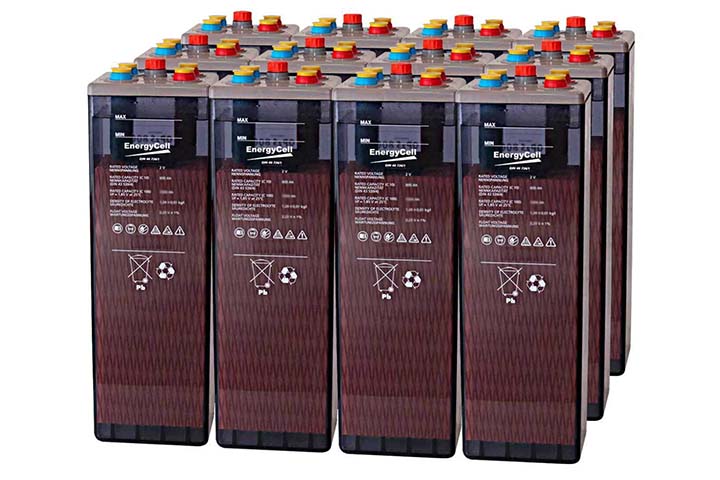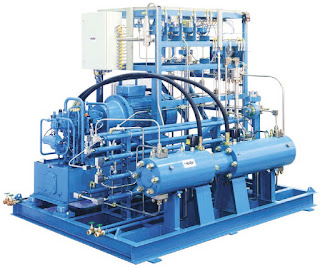Reciprocating compressor 101: An easy to understand guide to Piston Compressors
In this article, I want to talk about reciprocating compressors and tell you all about their parts and then talk a bit about Hydrovane compressors to help you make an informed decision when choosing the right compressor for your system. If you are interested to know more about them, don’t hesitate to read what comes next.
What is a
reciprocating compressor?
Reciprocating
compressor (also known as piston compressor) is a kind of compressor that
contains a crankshaft to drive the piston, resulting in the delivery of gasses
at high pressure.
The gas then
goes into the suction manifold and in the compression cylinder. This gas in
this part of the piston compressor will be compressed with a piston. A
crankshaft moves the piston in a reciprocating motion to compress the gas and
is then discharged. If you want to gain more general information about them,
you can check out this article.
Reciprocating
compressor applications
Piston
compressors are used in the petrochemical, gas, chemical and general industrial
processes. They can be used in many situations such as chemical plants, gas
pipelines, oil refineries, refrigeration plants, air conditioning, and natural
gas processing plants.
Different Reciprocating Compressor Parts
In the previous
sections, we learned about piston compressors and their applications in the
industry. Now we will dive deeper into knowing different reciprocating
compressor parts to learn their name and use in the system.
There are
several parts used in different designs of these compressors. I will introduce
the most important parts and explain a bit about them.
There are
several basic parts used in the piston compressors including: cylinders,
piston, piston rod, rod packing (tangent ring, backup ring, radial ring or
pressure breaker ring), and bearing, crosshead, valve (ring type valve, plate
type valve, poppet type valve), connection rod, distance piece, crankshaft, and
lubrication system.
Cylinders are one of the most important parts of reciprocating compressors.
Cylinders are used to reduce the temperature in the compression cycle. These
cylinders are attached to the frame using a distance piece that works as an
intermediate part and are usually created with cast iron for low-pressure and
large cylinders, and steel for high-pressure and smaller cylinders. It can be
separated from the frame too. Cylinders are equipped with replaceable liners
which provide a surface for the wearing portion of the cylinder. The purpose of
using them is to eliminate the cost of replacing the whole cylinder when the
bore has been scored or worn. Though in the smaller ones, it’s not economical
to use replaceable liners.
A piston
can convert the crankcase’s energy to the gas that’s in the cylinder. This part
is made of aluminium. It is equipped with piston rings that are a set of
sliding seals to help seal the space between the cylinder and the piston to
avoid the leakage of compressed gas. These rings usually have a
self-lubricating property to decrease the friction force between the piston and
the cylinder caused by sliding.
Cross Head has been implemented inside a piston compressor to guide the
piston in the cylinder bore.
Piston Rod has been designed to transmit the motion from the crosshead to the
piston. This part is threaded to the piston and is constructed of alloy steel.
The crankShaft
is another part of reciprocating compressors. It helps moving the piston
with a reciprocating motion to compress the gas. Large compressors (usually
above 150 kW) have forged steel crankshafts and others have iron crankshaft.
When above 800rpm, this part should be dynamically balanced.
The valve
is also among the important parts of these compressors. It has two types:
Spring-loaded and Gas-actuated and has three configuration types: Ring type,
Plate type, and Poppet type. The valve can control the flow in the compressors.
These were
among the most important parts of reciprocating compressors. If you want to
learn about other parts as well, you can click on this link and
gain many detailed and useful information about this compressor, its parts, and
their use and application.
Now, let’s
review one of the most famous piston compressors briefly:
Piston
compressors are also referred to as single-phase compressors. Hydrovane
compressor is considered as one of the famous single-phase compressors that
have been designed to provide consistent and dependable air supply.
Why should I
choose a Hydrovane Compressor?
These
compressors are popular because they have low noise level, and contain fewer
components which reduce the energy for maintenance. They also provide
high-quality air because they have less than 3ppm OCO! This type is also
durable enough and works for more than 100,000 hours.
Hydrovane
compressors can be used in farm and agriculture, automotive and garage, food
and beverage, medical and dental, and lots of other industries to help us work
better and smarter. If you want to learn more about Hydrovane compressors,
visit this website and gain lots of useful information.
Did you enjoy
reading about reciprocating compressors? How about sharing your opinion with us
in the comment section?
**
Sources:
https://en.wikipedia.org/wiki/Reciprocating_compressor
https://www.machinerylubrication.com/Read/775/reciprocating-compressor
http://www.mechanicalengineeringsite.com/reciprocating-compressor-basic-parts/
https://www.linquip.com/blog/reciprocating-compressor/
https://www.linquip.com/blog/hydrovane-compressors/
https://www.directair.co.uk/products/air-compressors/how-do-air-compressors-work/
https://www.linquip.com/blog/reciprocating-compressor-parts/



Comments
Post a Comment